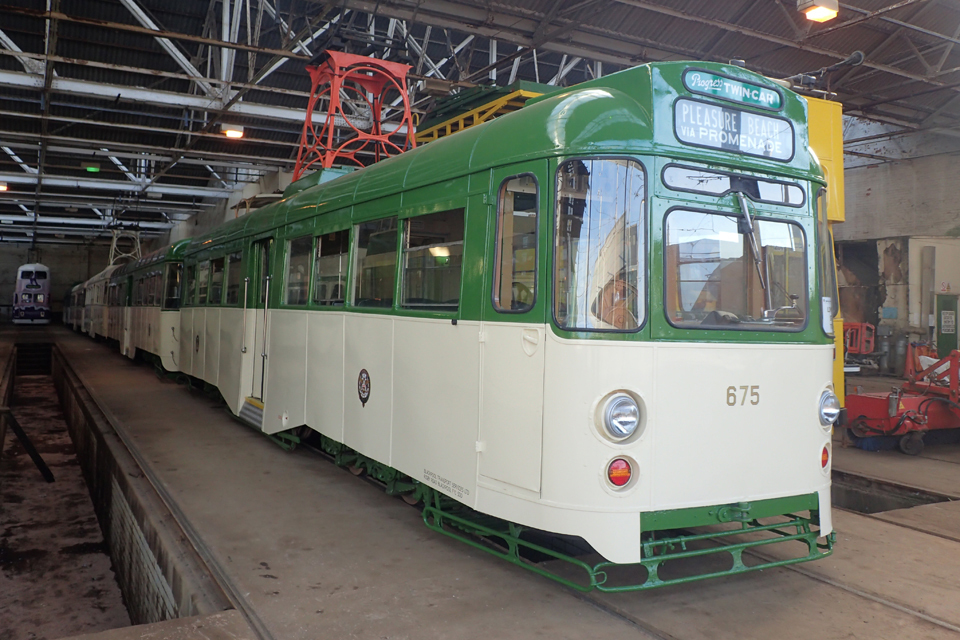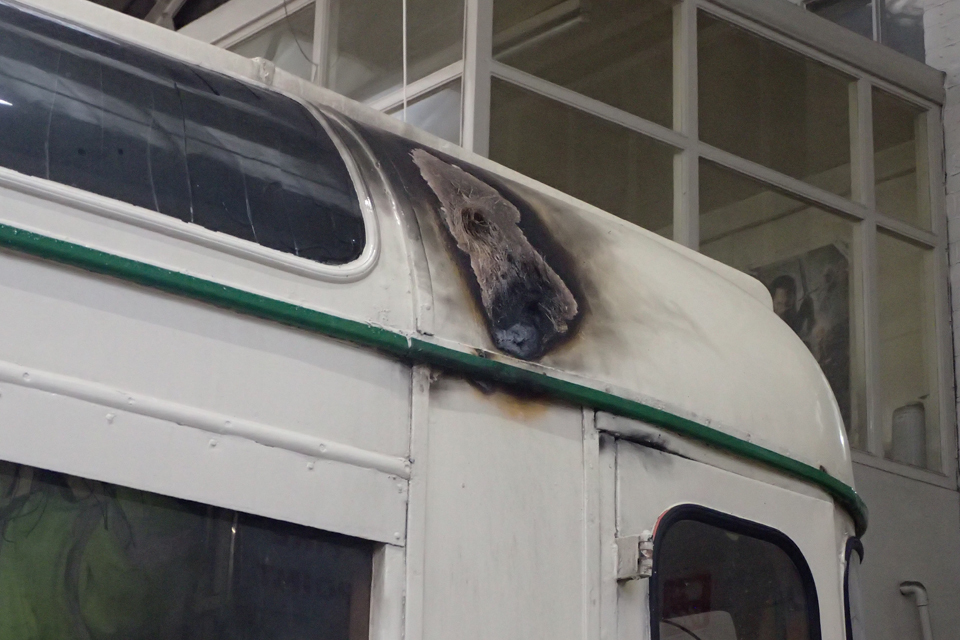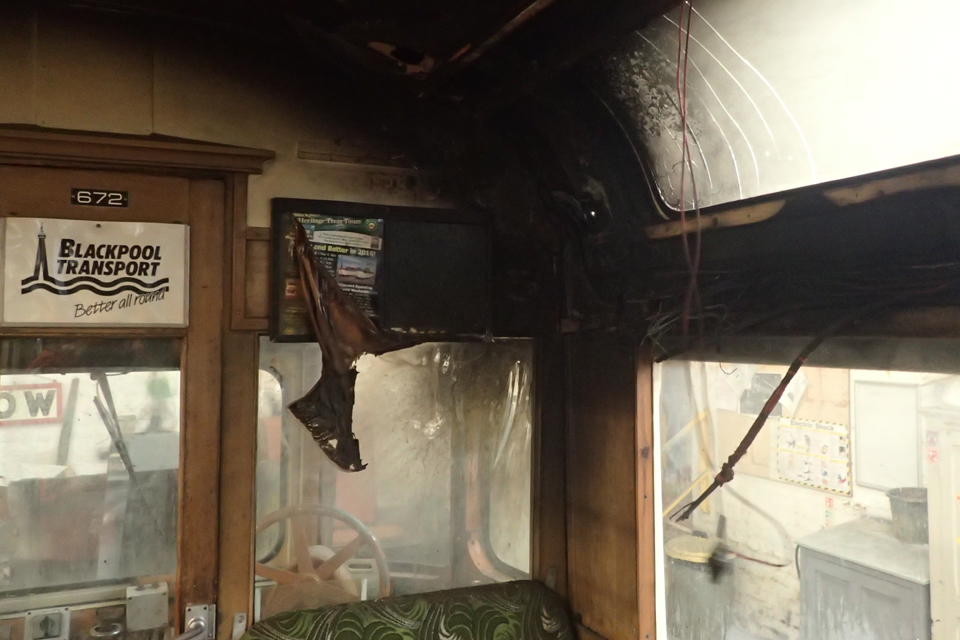Fire on heritage tram at Gynn Square, Blackpool, 24 September 2016
Published 22 December 2016
1. Important Safety Messages
This incident illustrates the importance of:
- Ensuring that staff involved in the operation of electrically-powered vehicles (both light rail trams and heavy rail vehicles) are aware of all means of removing the traction supply from the vehicle in an emergency. This can include lowering pantographs (or trolley poles) or requesting an emergency isolation from the appropriate control room.
- Managing the risks associated with ageing cables on heritage vehicles, particularly tramcars. Owners and operators of such vehicles should ensure that they understand the types of cables fitted to vehicles, and take appropriate steps to manage the risks accordingly, such as by avoiding partial repairs to old cables with old and fragile insulation susceptible to mechanical damage. Also noting that an insulation test in dry conditions may not be sufficient to detect degraded cable insulation on some vehicles.
- Ensuring that, where emergency equipment is protected from misuse by means of ‘break-glass’ panels or similar, such panels are of a design that minimises the risk of injury.
2. Summary of the incident
On Saturday 24 September 2016, heritage tramcar number 272 operated by Blackpool Transport Services (BTS) caught fire. This tramcar was part of a two car unit, known as a Progress Twin-car. In the UK, twin-car trams are currently only operated at Blackpool. The twin-car unit consisted of a trailer car (in this case vehicle T2) and a motor car (272). The motor car carries a pantograph to collect electric power from the 600 volt overhead supply. The twin-car unit has a driving cab at each end. This allows the unit to operate in either direction.

A Progress Twin-car tram in green and cream livery, similar to 272/T2. the tram is in the depot with other trams in the background. An open inspection pit is shown to the left hand side.
At the time of the fire, the unit was travelling north from Blackpool town centre. The trailer car (T2) was leading, and the unit was being driven from the leading cab of that vehicle. In addition to the driver, the unit was carrying two conductors, one in each of the two vehicles. At approximately 12:00 hrs, the unit had left Gynn Square tramstop towards the Cliffs Hotel stop. The driver was alerted to an electrical problem by a flash and loud bang from the buzzer unit in his cab. The conductor then advised the driver that there was a fire in the motor car. The driver brought the twin-car to a stand, and all passengers and staff evacuated without injury.

External scorching to the bodywork of tram 272. A large patch of blackened paintwork can be seen.

Internal damage to tram 272 showing damaged roof panels and internal woodwork around the windows. Wires can be seen hanging down with damage to other internal fittings.
When the unit came to a stand, the driver decided that it was necessary to remove the electrical supply from the motor car. He opted to do this by using a pole (provided for this purpose) to lower the pantograph on 272; the only pole available was stored within the saloon of 272. The driver therefore had to enter the smoke-filled saloon in order to retrieve the pole and he then lowered the pantograph. A safer course of action would have been for the driver to place a radio call to the Tramway control office and request an emergency isolation of the overhead supply. However, the driver was unaware of this option because it had not been included in his training.
The conductor on the trailer car retrieved a portable powder-type fire extinguisher which was stored in a cupboard accessible by a ‘break glass’ panel. The conductor sustained injury to his hand when he used it to break the glass.
A member of the public attempted to fight the fire using a water extinguisher obtained from nearby premises. Applying water to the live electrical system exposed the member of the public to risk and made the fire worse. The fire was subsequently extinguished by the fire brigade.
3. Cause of the incident
The fire was caused by the failure of the insulation on a cable which ran from the pantograph, via a roof fuse, to the main circuit breaker on the vehicle. This cable was constructed using Vulcanised India Rubber (VIR) insulation. The cable installed on car 272 comprised multiple copper cores surrounded by VIR, and a woven cotton outer layer.
Car 272 was built in 1935 as a single-vehicle tram known as an ‘English Electric Railcoach’. In 1960, it was converted to its current configuration as the motor car of a twin-car unit. BTS believe that the VIR cable was installed during this conversion. VIR cable insulation degrades over time (for example, see here) and the degradation makes the cable insulation more susceptible to mechanical damage. During May 2015, cable repairs were carried out very close to the cable which subsequently failed. This repair work could have caused damage to adjacent cables. It is possible that the insulation failure and fire were caused by such damage, combined with water ingress into the vehicle (see later).

Fire damaged cabling within the roof space of tram 272. The previous cable repair is indicated by a large red arrow on the right hand side.
As is common with older tramcars, car 272 was built of non-conductive materials comprising wooden and fibreglass panels on a teak frame. In the absence of extraneous conducting materials, such as water, significant current will not flow to earth even from a cable with degraded insulation. The cables on 272 were subject to a satisfactory insulation test in February 2016 when BTS believed that the vehicle was dry. Due to the severe localised fire damage it is impossible to be certain about the exact development of the fire. It is likely that, subsequent water ingress from the weather and/or routine washing of the vehicle created an unintended path for current to flow. This current flow caused the cable to heat to a point where it caught fire. It is unclear if the initial ignition occurred in the woven cotton surrounding the cable or in the timber structure in close proximity to the cable.
The vehicle control cables run in close proximity to the cable which failed, and these control cables were also damaged in the fire which led to the failure of the buzzer unit in the cab of car T2.
4. Previous similar incidents
In 2007, a prototype tramcar (611) caught fire at Blackpool (see RAIB report 41/2007). It is probable that the fire was caused by an electrical failure. During that incident, a prompt call to the tramway control office led to the isolation of the overhead supply after the driver was unable to remove the pantograph from the overhead wire.
You can print this safety digest.

